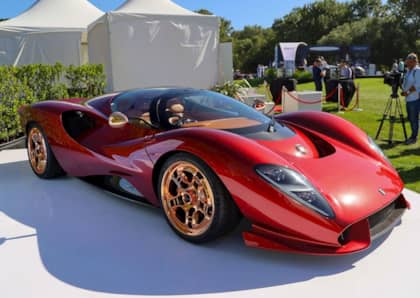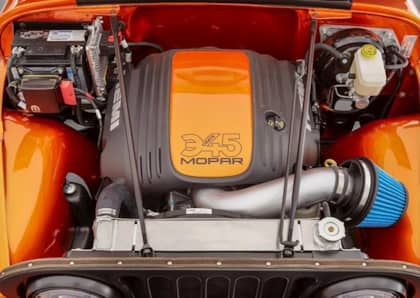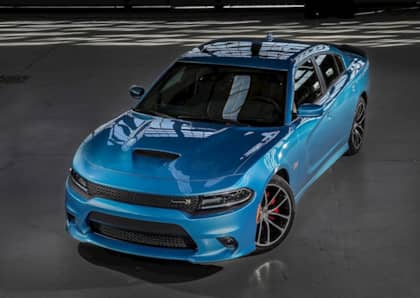10 European-Bred Muscle Machines With Thumping American Hearts
Almost every enthusiast is familiar with the legend of the Shelby Cobra, the game-changing sports car that combined the platform of the small and nimble British AC roadster with the brute force of Ford-sourced American V8 muscle in the 1960s.
Fewer people realize, however, that the 'American engine in a European chassis' concept was a fairly popular one throughout that decade and the next. The end result of all of this cultural cross-pollination was a small fleet of Yankee-powered exotica cruising around the continent—and, occasionally, making it across the Atlantic to ply U.S. highways.
Check out these 10 European-bred muscle machines with thumping American hearts and see how many you recognize.
1. Jensen Interceptor
It makes sense to start out with one of the best-known classic V8 imports—the Jensen Interceptor. Built between 1966 and 1967, the British coupe offered a pair of Mopar motors under the hood. Initially, the Interceptor came with a 383 cubic inch mill good for 335 horsepower, but by 1971 Jensen had moved to a 305 horsepower 440 CID engine (which it would stick with, despite gradual de-tuning to the 255 horsepower range, for the remainder of production).

Intriguingly, the Interceptor would also give birth to the somewhat longer, but similarly-styled Jensen FF, which was a four-wheel drive, 440-powered novelty of which on 320 were ever built.
2. Gordon-Keeble
From the best-known (after the Cobra) British muscle machine to perhaps the least, the Gordon-Keeble was the perfect example of the 'built in a shed' ethos that would power many of the U.K's post-war motor brands. The GK1 or GT was a grand touring car that built on the lessons learned by the company's namesakes in their previous venture (Peerless), which meant it had a spaceframe, fully-independent suspension, and a fiberglass body designed by Bertone that helped to keep weight down.

Although the concept car was motivated by a 283 CID Chevy engine, it would upgrade to a 327 CID good for 300 horsepower when it eventually went on sale in 1964. Less than 100 were ever built before the company went out of business after 1967.
3. Iso Grifo
The Iso Grifo takes the grand touring script and flips it over to Italy, where in 1965 it appeared on the scene as part of a genuine bid to draw customers away from established players like Alfa Romeo and Ferrari. Again, Bertone was involved - specifically, Giorgetto Giugiaro - and it turned up the wick on its Chevrolet 327 V8 to generate 400 horsepower. Iso wasn't loyal to any particular engine builder, and the Grifo would see a 454 Chevy and a 351 Ford eventually take over as it moved through various iterations from '65 to '74. Not only was the car mighty, but it was also ultra-light, tipping the scales at a mere 3,200 lbs.

Fun fact: Iso was also the company that built the famous Isetta 'bubble' car that BMW licensed for its own production, and which hit the pop culture consciousness again in the 90s after it showed up on TGIF television as Steve Urkel's ride.
4. De Tomaso Pantera
The De Tomaso Pantera is just as well-known as the Jensen Interceptor when it comes to Europeans with an American influence. Who could ever ignore this swooping, mid-engine sports car, which despite its Italian-sounding name was actually the brainchild of an Argentinean entrepreneur and racer named Alejandro de Tomaso. After stints at Ghia and Vignale, de Tomaso would bring the car bearing his name into reality in partnership with Tom Tjaarda, who would pen its arresting shape.

Powered by a 351 cubic inch Ford V8 that hovered near the 400 horsepower mark, the Pantera has been celebrated not just for its performance but for its ease of mechanical maintenance—a rarity for pseudo-Italian hardware. The coupe would be available, off and on (depending on De Tomaso's fortunes) from 1971 to 1993.
5. Bitter CD
Like De Tomaso, Bitter takes its name from a race car driver, in this case Erich Bitter, a man who loved Italian cars but hated how unreliable they proved to be over the long run. The roots of the CD, however, are a little more unusual.

This two-door hatchback was originally conceived as an Opel, but despite being well received the car never made it past the concept stage. Bitter got wind of Opel exec Bob Lutz's interest in the project, and convinced the company to let him build it as a grand tourer under his own name. Fitted with a 327 V8 from Chevrolet, the Bitter was offered between 1974 and 1978, and featured 327 horsepower—not a bad number considering that the EPA had neutered most domestic muscle of that era by way of pollution controls and lead-free gasoline.
6. Facel Vega
The Facel Vega was the unique product of a French coachbuilder that attempted to pivot to becoming a full automaker when unibody construction started to winnow down its customer list. Given its origins, the Vega's gorgeous sheet metal is a given, but less obvious is its use of a DeSoto Hemi engine, a 276 cubic inch unit good for a stout 360 horsepower. The two-door Vega would eventually graduate to a 354 cubic inch Chrysler motor, and the Vega II even featured a choice between a 383 Typhoon churning out 355 horsepower, or a 413 Wedge.

Facel would build its Vegas from 1954 to 1964 under a variety of badges denoting equipment and features, but fewer than a thousand were ever produced.
7. De Tomaso Mangusta
De Tomaso's first swing at a sports car was the Mangusta, or 'mongoose.' Available between 1967 and 1971, it served as something of a proving ground that would establish a foundation for the Pantera, and it walked the same mid-mounted Ford V8 line (in this case a 300 horsepower 289).

Only 401 Mangustas were ever built, but it was plagued by expensive construction and a shocking rear weight bias, with a full 68 percent of its mass sitting over the back axle. This made it somewhat of a challenge to drive quickly, especially when approaching its 155-mph top speed.
8. Iso Rivolta
Like the Mangusta, the Rivolta was Iso's prelude to its Grifo main course. Similar in looks to BMW coupes of the day, the Rivolta was meant to appeal to fans of sporty driving who still had to commute to work on Monday morning.

Built from 1963 to 1970 in various styling guises, the Rivolta undercut contemporary GT cars from Ferrari by nearly 50 percent, thanks in part to the cost-cutting measure of using Corvette 327 V8s rather than a homegrown engine program. The combination of pricing, style, and performance ensured that 800 Rivoltas were sold in total.
9. De Tomaso Longchamp
The last of the De Tomasos on our list is the Longchamp, a vehicle with a production run nearly as long as that of the Pantera (1972-1989). A squared-off handsome coupe (with a handful of convertibles built, too), the Longchamp chopped the Deauville sedan platform and also featured Tjaarda's influence as a designer.

The front-engine touring car came with the same 351 cubic inch Ford V8 as the Pantera, but it came standard with an automatic transmission to reflect the fact that it was aimed at the cruising, not the track crowd. With 330 horsepower in its initial iteration, De Tomaso would eventually have to import Australian-built 351s for its fleet of high performance machines once the Detroit supply ran dry in the 80s.
10. Bizzarrini GT 5300
You may have noticed by now that the Italian and British sports car worlds were fairly small in the 1960s and 70s—and the Bizzarrini GT 5300 is another vehicle with a familiar cast of names behind its genesis. Giotto Bizzarrini himself had made the move from Ferrari (where he worked as chief engineer) to Iso before breaking away from the company to make his own track-oriented version of the Grifo called the A3/C.

The Bizzarrini GT 5300 was essentially an A3/C with a 365 horsepower Corvette 327 and a largely aluminum body, and it featured a far more aggressive look than the comfort-oriented A3/L version of the Grifo. Also known as the GT 5300 Strada, roughly 115 of these beasts were constructed between 1965 and 1968, and their value currently hovers around the million dollar mark on the auction circuit.











